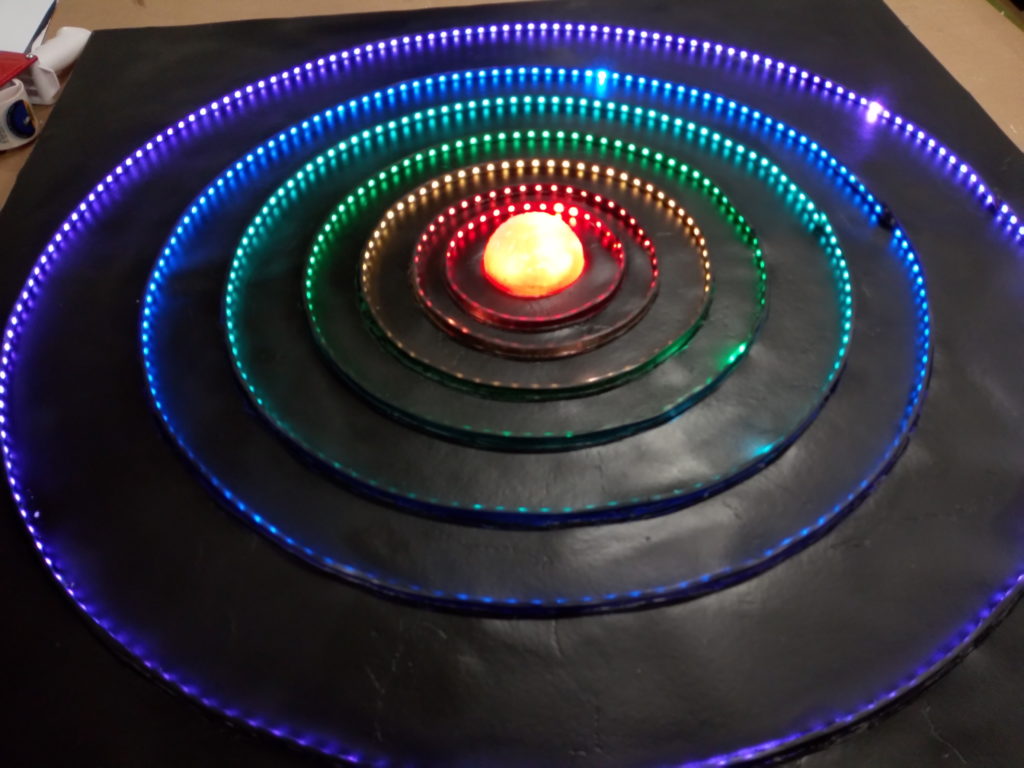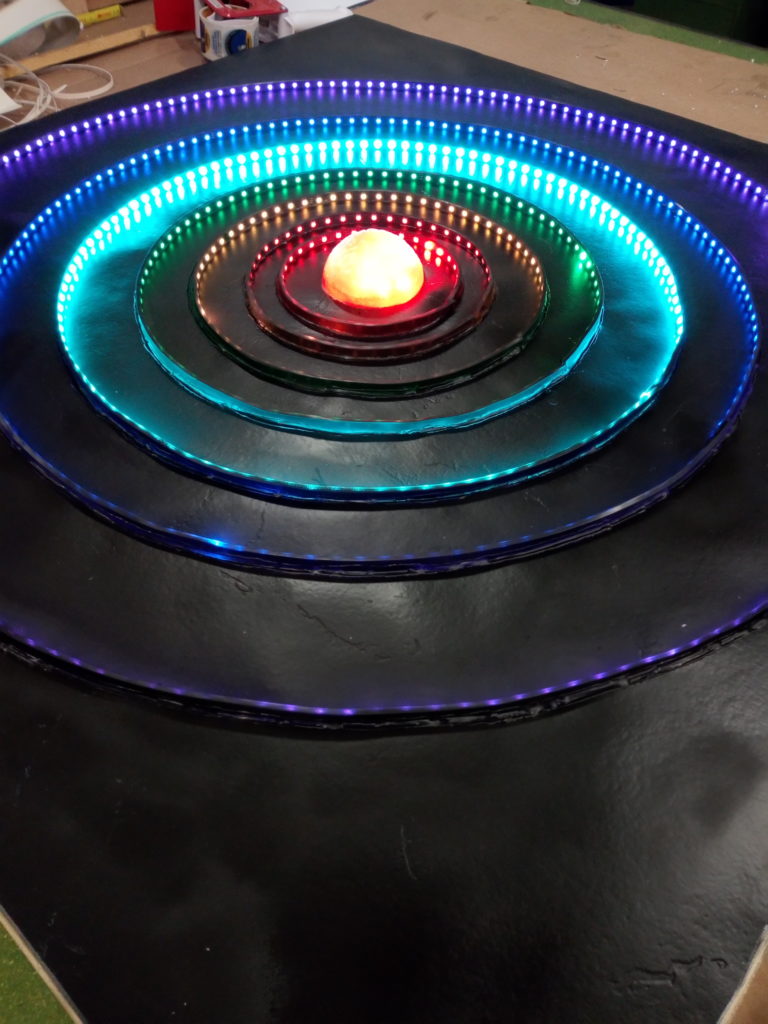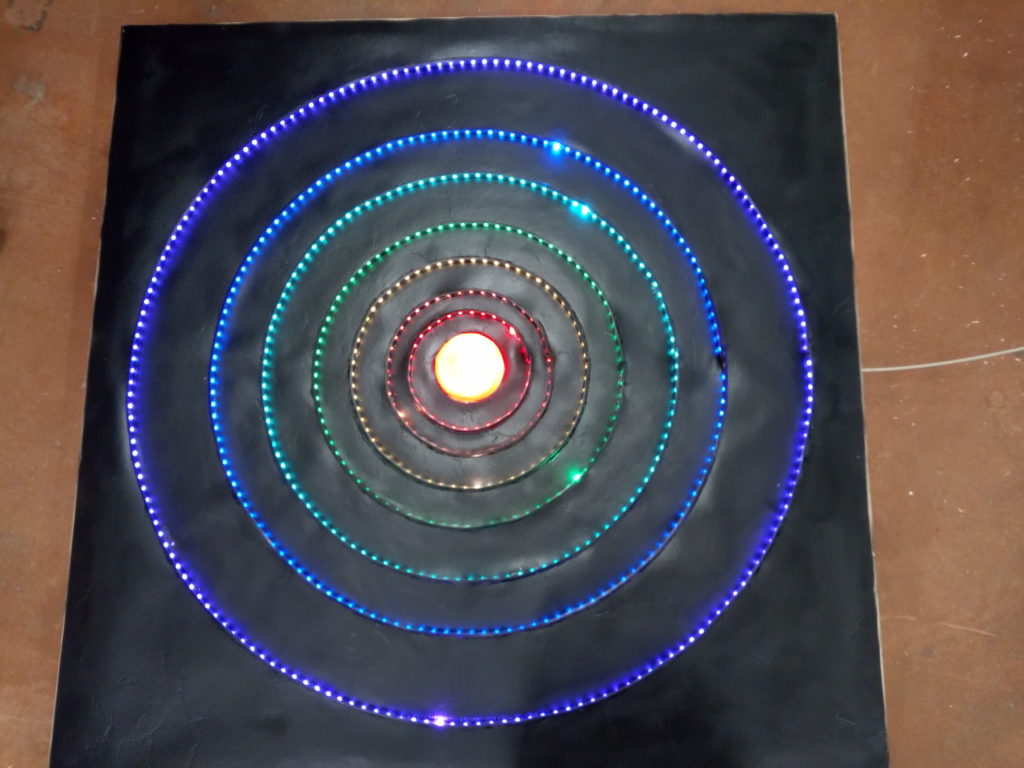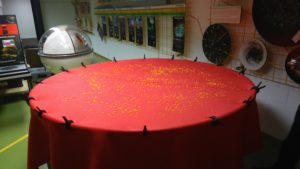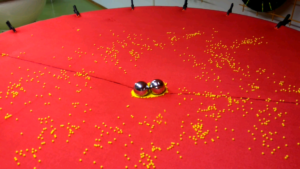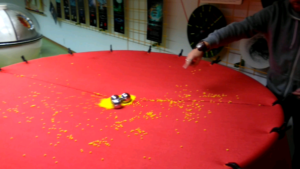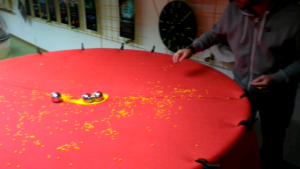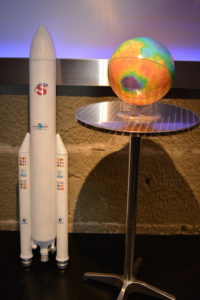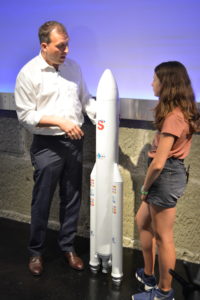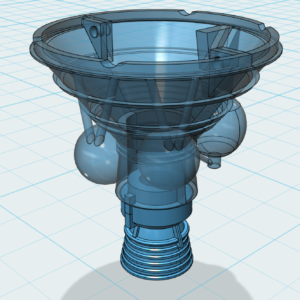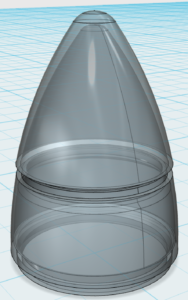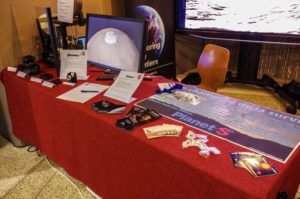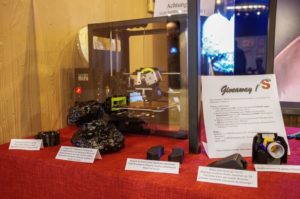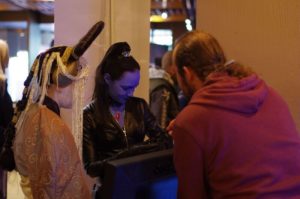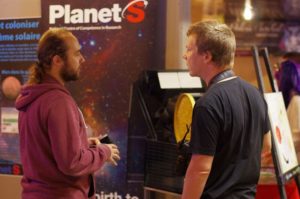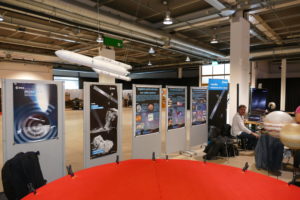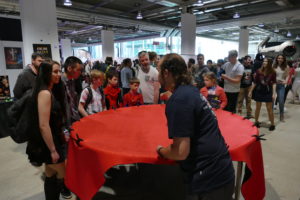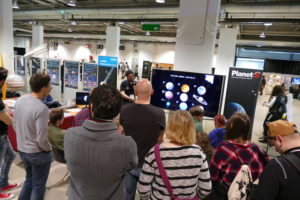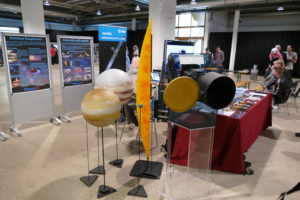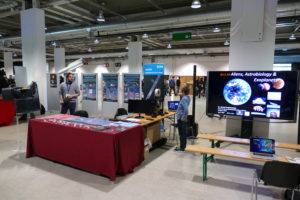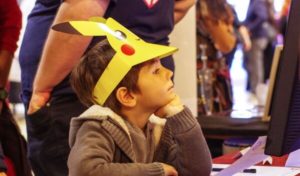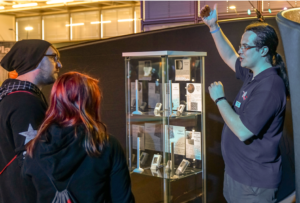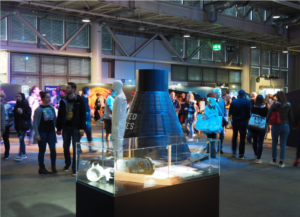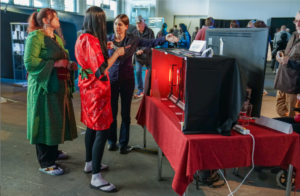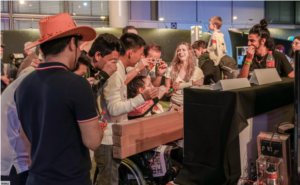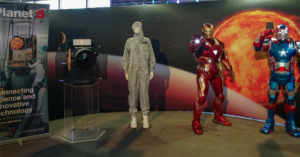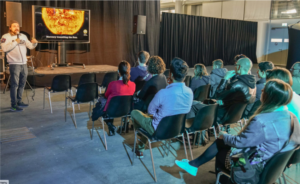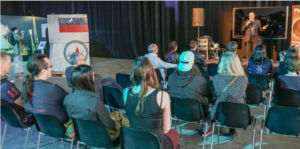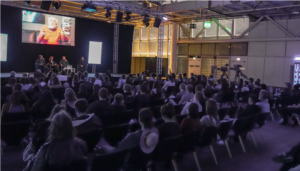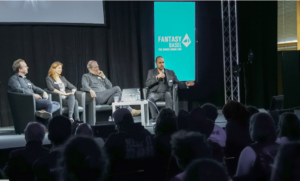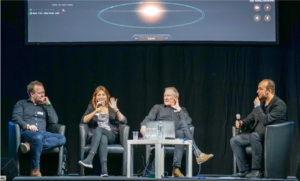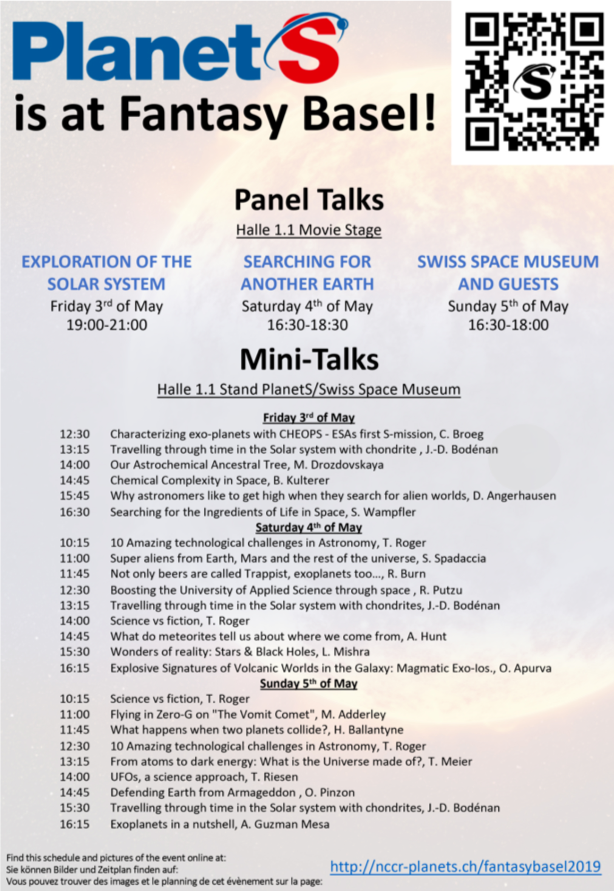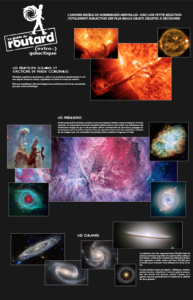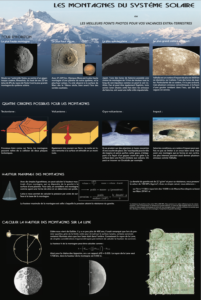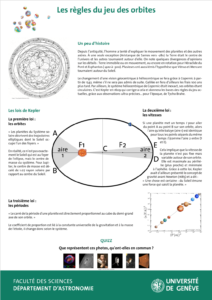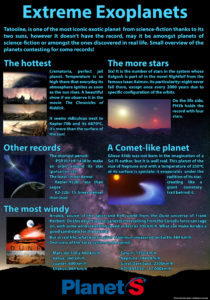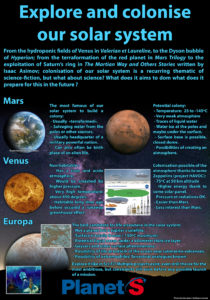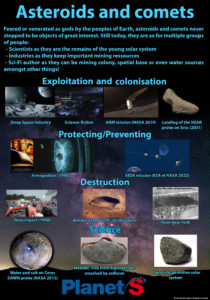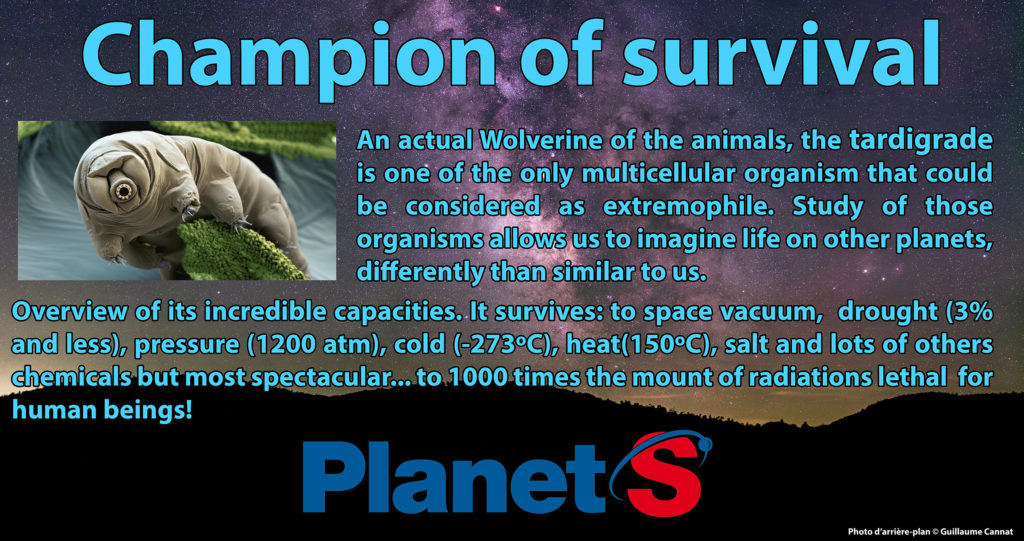Over the last years, I have carried out multiple outreach activities and developed many projects, you will find details for each of them in the following tabs.
Click on the tabs for more details on the various projects.
- Trappist-1 sound and light show
- Gravity visualisation table
- Ariane V rocket model
- Exhibition during Science-Fiction conventions
- Outreach Posters and Talks
It is my latest project, still in the final stage of building. This was inspired by the awesome Trappist-1 pinball by HotPopRobot itself inspired and done in collaboration with SYSTEM Sounds, the makers of the famous Trappist sounds video.
The sound and light show of Trappist-1 is a one meter by one meter model of the Trappist-1 system to the 1/200 000 000 000 spatial scale and 1/50 000 temporal scale. The orbits are at scale and made of individually addressable RGB LEDs. The only thing not to scale is the M-dwarf star in the center, at it would otherwise be smaller than 2 mm. Each orbit as a different colour and a brighter LED represent the position of the corresponding planet around the star. When reaching a specific point of the orbit, all the orbit is lighting at full brightness to indicate the transit of the planet (one specific direction on the board). It addition, when two neighbouring planets are aligned with the star, a portion of their orbit flash in white, to help visualise the resonances. The phases of the planets are correct but their periods have been slightly adapted in order to show perfect resonances. Indeed, one of the goal of this project, in addition to catch eye and look beautiful and mesmerising, is to have a support to explain several exoplanet concepts: transit detection, TTV (although it doesn’t show any), compact systems, resonances and planetary system architecture.
The sound has not been implemented yet but is in the process to be. Once it will have been completed, all the ressources to build it will be available in open-access on this website. Everything has been made with off the shelf component and the electronic is based on an arduino controller making it easy to reproduce. The code running the arduino will also be made available once the sound will be implemented. This model (same dimensions, etc.) can be built for an approximate price of 250€.
Based on the popular « Gravity visualized » video from Dan Burns, I developed a similar gravity visualisation table for the Observatory of Geneva. The basic principle is the same but the execution is different. The table is a 2 meter diameter metallic circle, covered in a 7mm thick neoprene fabric, representing the fabric of space-time. With various accessories, the table enables to demonstrate a large number of physical phenomenons, and can be used for ~half an hour of explanation of various concepts related to gravity.
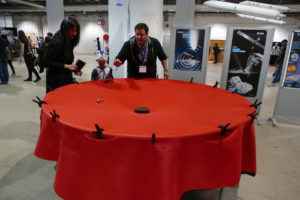
The current sequence of concepts to visualise with the table:
- Curvature of space-time, depending on the mass
- Gravitational attraction
- Orbits: circular and elliptic
- Center of gravity and concept of radial velocities
- Notion of « local gravity dominant body »: Hill radius
- Star-Planet-Satellite system
- Tidal disruption and Roche lobes
- Lagrange points, L1 particularly
- Black holes concept
- Gravitational Lenses, very practical to explain them, and their interest to study both the lensing object and the distant lensed object, and thus also micro-lensing.
- Planetary system formation by accretion scenarii.
- Disc structures
I developed a 1.5 meters tall Ariane V rocket model, the elements were 3D modelled and 3D printed to scale, except for the pipe sections (simple plastic pipe from hardware stores). The primary goal of this model is for exhibition only, as it is a good eye-catcher to spark interest from people. However, it can also be used to explain how a rocket work and the various components, as did Thomas Zurbuchen, Head of NASA Science Mission Directorate, during the recording a TV show for kids (see pictures below).
Fans of science-fiction or « geeks » are usually more interested into science than the general public. As such, they are an ideal target audience for outreach. With this in mind, I developed an outreach project with a stand and exhibition booth for science-fiction convention. So far, this stand was used during the following event: Swiss Fantasy Show 2016 in Morges, and Fantasy Basel 2017, 2018 and 2019 in Basel. Those events attracted respectively ~8000, ~40 000, ~55 000 and ~60 000 visitors over a week-end. You can see a video of our first stand in 2016 here.
The last edition (Fantasy Basel 2019) I coordinated, this project had grown beyond my hopes, with a 600 square meter stand in collaboration with the Swiss Space Museum. Amongst their itinerary exhibition « Lift off to Space« , featuring rocket parts, astronauts suits, a Mercury capsule, etc. were various exhibition and experiments propose by the NCCR PlanetS for the public. We also managed a mini-stage on the stand with a continuous series of mini-talks by scientists and engineers. Finally, on the medium stage of the event (300 seats), we conducted 2 panels of experts on various astrophysics and space sciences subjects, one of which I moderated. You can find a complete gallery of this event on the NCCR PlanetS website.
Fantasy Basel 2019
I made various posters and talks for outreach exhibitions.
- Posters:
- Hitchhikers Guide to the Galaxy phenomenons: Nebulae, Solar flares and Galaxies. (2017, formatting by Sylvia Ekström)
- Mountains of the Solar System: Overview with some records, 4 possibles origins and maximal height. (2017, formatting and content about calculating mountains’ height on the moon by Sylvia Ekström)
- Science vs science-fiction series (2016-2018):
- Extreme Exoplanets
- Champion of Survival
- Explore and Colonise our Solar System
- Asteroids and Comets (content by Pierre Bratschi)
- The laws of Kepler for Night of Science 2016 themed about « The rules of the game » (formatting and illustration by Sylvia Ekström)
- Talks:
- Exoplanets: how to detect them. August 2014 – Web conference.
- Does science-fiction movies cheats with Physics? 2016-2017 – Various outreach events.
- Can a planet have 2 stars like Tatooine?
- Can our world become an ocean-planet like in Waterworld?
- Can you suck the power from your star like the Starkiller base?
- An overview of exoplanetary sciences, from detection to characterisation. March 2018 – Invited talk – Fribourg. And November 2018 – Bern.
